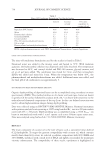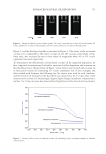731 PHYSICOCHEMICAL PROPERTIES OF TEXTURED HAIR (42) M. Trotter, Anthropometry, Am. J. Phys. Anthropol., 24(1), 105–126 (1938). (43) K. Leerunyakul and P. Suchonwanit, Asian hair: a review of structures, properties, and distinctive disorders, Clin. Cosmet. Investig. Dermatol., 13, 309–318 (2020). (44) L. C. Lee, W. N. S. Wan Mohamad Fuad, S. S. Abdullah, and K. L. Ong, Preliminary study on morphometric analysis of the human scalp hair for discrimination of ethnic Malay and ethnic Chinese in Malaysia, Egypt J. Forensic Sci., 9(1), (2019). (45) Y. Kalmoni, F. K. Addai, S. K. Adjenti, K. K. Adutwum-Ofosu, J. Ahenkorah, B. A. Hottor, and R. M. Blay, Light microscopic morphology of indigenous Ghanaian African hair from scalp, eyebrow, axilla, and pubic regions, Int. J. Trichology, 11(1), 8–13 (2019). (46) G. Loussouarn, I. Lozano, S. Panhard, C. Collaudin, C. El Rawadi, and G. Genain, Diversity in human hair growth, diameter, colour and shape. An in vivo study on young adults from 24 different ethnic groups observed in the five continents, Eur. J. Dermatol., 26(2), 144–154 (2016). (47) G. Loussouarn, African hair growth parameters, Br. J. Dermatol., 145(2), 294–297 (2001). (48) D. Van Neste, Thickness, medullation and growth rate of female scalp hair are subject to significant variation according to pigmentation and scalp location during ageing, Eur. J. Dermatol., 14(1), 28–32 (2004). (49) P. E. Hutchinson and J. R. Thompson, The size and form of the medulla of human scalp hair is regulated by the hair cycle and cross-sectional size of the hair shaft, Br. J. Dermatol., 140(3), 438–445 (1999). (50) C. Robbins, Chemical and Physical Behavior of Human Hair (Springer, Heidelberg, Germany, 2012). (51) M. Feughelman, “Morphology and properties of hair,” in Hair and Hair Care, Cosmetic Science and Technology. D. Johnson. Ed. (Marcel Dekker, New York, NY, 1997), pp. 1–12. (52) J. Swift, “The structure and chemistry of human hair,” in Practical Modern Hair Science. T. Evans and R. Wickett. Eds. (Allured Publishing, Carol Stream, IL, 2012), pp. 1–37. (53) P. Prem, K. J. Dube, S. A. Madison, and J. Bartolone, New insights into the physicochemical effects of ammonia/peroxide bleaching of hair and Sepia melanins, J. Cosmet. Sci., 54(4), 395–409 (2003). (54) G. A. Camacho-Bragado, G. Balooch, F. Dixon-Parks, C. Porter, and H. Bryant, Understanding breakage in curly hair, Br. J. Dermatol., 173(Suppl. 2), 10–16 (2015). (55) N. P. Khumalo, R. P. Dawber, and D. J. Ferguson, Apparent fragility of African hair is unrelated to the cystine-rich protein distribution: a cytochemical electron microscopic study, Exp. Dermatol., 14(4), 311–314 (2005). (56) E. Cloete, N. P. Khumalo, and M. N. Ngoepe, Understanding curly hair mechanics: fiber strength, J. Invest. Dermatol., 140(1), 113–120 (2020). (57) M. G. A. Leite and P. M. B. G. Maia Campos, Mechanical characterization of curly hair: influence of the use of nonconventional hair straightening treatments, Skin Res. Technol., 23(4), 539–544 (2017). (58) Y. Yu, W. Yang, B. Wang, and M. A. Meyers, Structure and mechanical behavior of human hair, Mater. Sci. Eng. C Mater. Biol. Appl., 73, 152–163 (2017).
732 Address all correspondence to Lyndsay Leal, lmleal@dow.com Enhanced Natural Oil Deposition Using Acrylic Copolymers LYNDSAY LEAL, MICHAELEEN PACHOLSKI, BETH JOHNSON, JENNIFER KOENIG, SHANNON GOLDEN AND LU BAI The Dow Chemical Company, Collegeville, Pennsylvania, USA (L.L., M.P., J.K.) The Dow Chemical Company, Midland, Michigan, USA (B.J., S.G., L.B.) Synopsis Natural oils have become increasingly prevalent in hair care products over the past decade and continue to gain traction in the market. While analytical methods exist in the field to understand the deposition and mechanism of action for silicone emulsions, which are chemically distinct from hair fibers, the visualization of natural oils on the hair surface has been an analytical challenge. In this work we showcase a new class of oil-soluble acrylic copolymers that structure coconut oil and enhance the deposition of the active onto the hair fibers. Additionally, we highlight the use of secondary ion mass spectrometry and depth profiling of the hair fibers to visualize the deposition of structure oils onto the hair surface. Lastly, we explore the utility of these structured oils in hair conditioning applications. INTRODUCTION In recent years, coconut oil has been a very popular ingredient in personal care formulations. This triglyceride oil is extracted from the coconut palm (Cocos nucifera) and is a source of long-chain saturated fatty acids (1). Over the past decade, the use of coconut oil in hair care products has grown in popularity across big and small labels all around the globe (2). Coconut oil has been shown to reduce hair damage when used as a prewash conditioner to improve the appearance of bleached, damaged hair (3). Data also show coconut oil outperformed sunflower oil and mineral oil, and coconut oil was the only oil that reduced protein loss due to excessive brushing and combing (4). As this natural oil becomes increasingly popular in shampoos and rinse-off conditioners, the need to efficiently deposit this material on the hair fiber is important. While cationic deposition aid technologies can be used to increase the deposition efficiency of the emulsified oils (5), we hypothesized that structured oil would have greater persistence on the hair surface. To this end, oil-soluble acrylic copolymers that can swell in the presence of natural oils were developed to provide structuring and increased viscosity of the oil phase (Figure 1). These polymers contain a lightly cross-linked hydrophobic acrylic backbone that is compatible with triglyceride oils. Once dispersed in the oil, the polymer swells and provides viscosity through a space-filling mechanism. Excellent thickening efficiency and J. Cosmet. Sci., 72, 732–740 (November/December 2021)
Purchased for the exclusive use of nofirst nolast (unknown) From: SCC Media Library & Resource Center (library.scconline.org)






































































































































